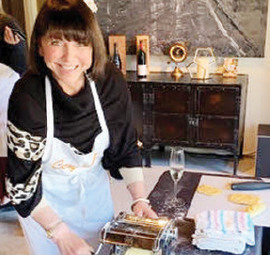
Cheryl Krafft
Nothing prepared me for a diagnosis of diffuse large B-cell lymphoma (DLBCL) in the fall of 2016. I had none of the typical symptoms of the cancer, such as night sweats, enlarged lymph nodes, or fatigue. In fact, my energy level was as high as ever, as I traveled around the country for business, and I felt fine. The only health problem I had was a chronic condition of kidney stones, which I had recently been treated for with an extracorporeal shockwave lithotripsy procedure. It wasn’t until a computed tomography scan of my kidneys after the lithotripsy found a large, suspicious mass on my spleen, did I know I had a possible serious health threat. A biopsy of the tumor determined that it was DLBCL, a cancer, I learned, that was aggressive, and I knew I had to act fast to find an oncologist and start treatment.
I’m thankful to the researchers who designed a clinical trial that I’m sure saved my life and to Dr. Westin and my entire oncology team, who took such good care of me throughout my treatment and survivorship.— Cheryl Krafft
Tweet this quote
I soon discovered, however, some more troubling news. Although the current standard treatment for DLBCL is R-CHOP (rituximab, plus cyclophosphamide, doxorubicin, vincristine, and prednisone), this non-Hodgkin lymphoma subtype does not respond as well to chemotherapy as other types of lymphoma. I wanted a more effective treatment option to put me in remission and maybe even cure my cancer.
I met with Jason Westin, MD, Assistant Professor of Medicine in the Department of Lymphoma and Myeloma at The University of Texas MD Anderson Cancer Center, who was launching a phase II clinical study investigating a combination of targeted therapies that included rituximab, lenalidomide, and the Bruton’s tyrosine kinase inhibitor ibrutinib (RLI), followed by six additional cycles of RLI and an intensive combination regimen of EPOCH (etoposide, prednisone, vincristine, cyclophosphamide, doxorubicin) chemotherapy. Among the primary objectives of the study was to learn whether a chemotherapy-free combination of RLI could be effective in patients with newly diagnosed DLBCL.1
Dr. Westin explained the potential risks and benefits of the clinical trial and said that I would likely have a durable response to the therapy.
Contributing to Science—and to Society
I decided to enroll in the study because, of course, I wanted a better shot at a cure, but I also wanted to contribute to important research that may make it possible in the future for patients like me to avoid conventional chemotherapy. Amazingly, after the first two cycles of RLI the cancer disappeared, although I still had to complete the study protocol of six more cycles of RLI plus EPOCH. (Editor’s note: The results of the clinical study showed that nearly 85% of the patients had an overall response rate and almost 40% achieved a complete response to RLI, prior to receiving chemotherapy.1)
Undergoing the chemotherapy part of the trial was very difficult. The treatment’s side effects, including hair loss, neuropathy in my hands and feet, and, most seriously, cardiac failure, put me in a dark place. I hope the results of the study may spare other patients from undergoing that experience.
Engaging in Multidisciplinary Oncology Care
The problem with my heart started as soon as I completed the chemotherapy regimen, but it wasn’t discovered until I saw a cardiologist. I had a baseline cardiac assessment for the symptoms I was having, including shortness of breath, fatigue, and irregular heartbeat. When the cardiologist found that I was in heart failure, I realized the severity of my situation. Fortunately, a new discipline of cardio-oncology has emerged to address chemotherapy-induced heart failure, among other cardiac issues. After a consultation with a cardio-oncologist, who recommended treatment with the beta-blocker metoprolol and the blood pressure medication spironolactone, I began to recover. It took more than a year for my heart function to improve and nearly 2 years for it to return to normal, and I’m thrilled to say I no longer have heart disease.
I’m also thrilled to say that I am cancer-free. In fact, after 2 years of close monitoring, Dr. Westin has declared me “cured” of cancer, and I feel humbled and extremely grateful.
Living in the Present
When I was diagnosed with DLBCL, I never asked “why me?” But I am left wondering what caused me—and others—to develop this cancer. Whatever the reason, having this experience has taught me I can no longer take life for granted. Until my diagnosis, I was rolling along thinking I had at least another 20 years of good health, but none of us can make such assumptions about the future.
Although I feel confident my cancer is cured, its memory haunts me, and I’m hoping I never have to deal with the disease again. I’m thankful to the researchers who designed a clinical trial that I’m sure saved my life and to Dr. Westin and my entire oncology team, who took such good care of me throughout my treatment and survivorship. They have given me my life back, and I won’t waste a minute of it. ■
Ms. Krafft lives in Sugar Land, Texas.
REFERENCE
1. Westin J, Nastoupil LJ, Fayad L, et al: Smart start: Final results of rituximab, lenalidomide, and ibrutinib lead in prior to combination with chemotherapy for patients with newly diagnosed diffuse large B-cell lymphoma. 2019 ASCO Annual Meeting. Abstract 7508. Presented June 4, 2019.
Editor’s Note: Columns in the Patient’s Corner are based solely on information The ASCO Post received from patients and should be considered anecdotal.

